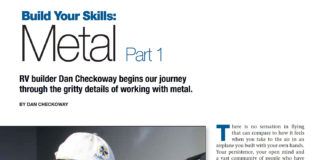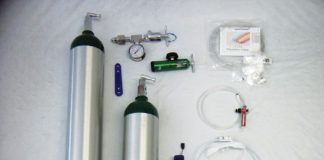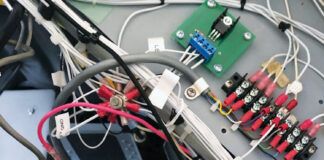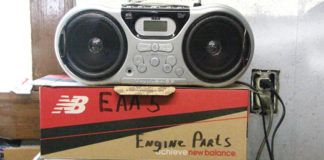Those who have considered the six-cylinder Corvair powerplant will no doubt have some familiarity with William Wynne, whose FlyCorvair.com has promoted the benefits of the backward-turning, direct-drive, air-cooled conversion for more than 20 years now.
With success comes notoriety, especially among such a close-knit community as Corvair engine builders. At some point, others recognize a good idea and jump in with supporting products of their own. Where FlyCorvair was just a loose confederation of propeller-heads a few short years ago, the movement has grown. Like-minded individuals have become a necessity to provide the products needed to keep improving airborne installations of the Corvair.
Some of the guys who decided to jump into this market did so because they liked the engine or Wynne or both. Others recognized a need for Corvair-related items that they could fill without too much difficulty, especially for a pressing need. This is what happened when some Corvair crankshafts began to develop cracks after racking up flight time.
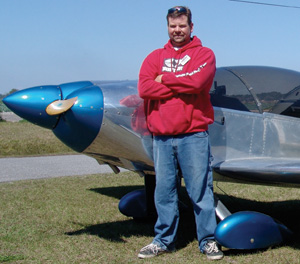
Cleanex builder Dan Weseman was concerned about reports of cracked Corvair crankshafts, so he created a fifth-bearing solution.
Fly Fifth Bearing
The son of an aviation mechanic, Floridian Dan Weseman grew up around airplanes, and was building a Sonex not long ago when he read an article about the Corvair conversion, and it seemed the perfect solution for his own engine needs. The kit manufacturer wasn’t crazy about the idea of using a Corvair, but Weseman did it anyway, and the result was dubbed the Cleanex. The Sonex flew so well that it wasn’t unusual to catch Weseman performing impromptu, positive G aerobatic routines a few thousand feet up in the sky.
When news of the Corvair crankshafts cracking, usually in installations with heavier props or prop extensions, swept through the community, the initial solution was to nitride-treat the crankshaft for increased surface hardness. But Weseman took no chances and grounded his own airplane until a more robust solution could be developed. The source of the cracking problem was isolated to gyroscopic side loads upon the crank, several inches back from the prop hub, where the first real case bearing handled the strain but still allowed some flex. A better solution: Support the crank closer to the hub.
I called William and discussed the problem, Weseman said, and we talked about all kinds of possible solutions. Wesemans familiarity with his dads work and his own experience installing industrial machinery streamlined the development of a cast fifth bearing that can be retrofitted without removing the engine from its mount. You can do it yourself in one or maybe two days, Weseman said. He calls it the BTA Fifth Bearing, for Better than Air.
Recognizing that one of the main attractions of the Corvair is its low cost, Weseman has tried to keep the price as low as possible. You pay for this engine with sweat equity when you build it yourself, Weseman said, and it just doesn’t make sense for Corvair parts to cost near what they do on a certified engine. His fifth bearing sells for about $1050, so far the least expensive of the solutions on the market. He will even lend the tools needed for a do-it-yourself installation, provided a deposit is placed up front to ensure hell get them back (www.jsweseman.com). Seeing the sudden activity in the Corvair aftermarket, his parents, Jim and Rhonda Weseman, have also jumped in with their own products, offering Corvair baffle and cowling kits for the Zenith 600 and 700 series aircraft.
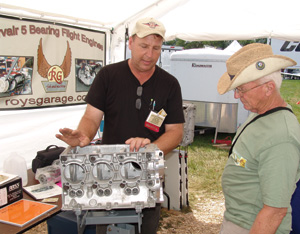
Roy Szarafinski displays his fifth-bearing solution at AirVenture 2010. An engine builder and machinist by trade, he built a Zenith 701 as a test bed for his engine developments.
Roys Garage
Michigans Roy Szarafinski has a long history with precision machining and automotive racing engines. He made the acquaintance of a neighbor, Ron Lendon, who worked for GM and was building his own Corvair aircraft engine. Szarafinski became intrigued and decided he could use his experience to create useful aftermarket products, the most notable being another fifth-bearing solution.
Why another crankshaft bearing product in a relatively tiny market? If you spend any time around Szarafinski, the answer is clear. Brother Roy, as hes sometimes called, is evangelical about producing the most precise solution possible, going to uncommon lengths to do so. His bearing is machined from solid aluminum billet, not cast. Its designed in two halves, so it may be removed and serviced easily. This is not a do-it-yourself project. He requires that the crankcase be sent to his shop so he can oversee the installation and alignment, as some case machining is required for a perfect fit.
Precision doesn’t come cheap. Mines $1695, Szarafinski said. The difference is that Im dealing with the entire case. When I line-bore it, Im within two ten-thousands of an inch. Were dealing with 50-year-old cases to start, and they’re all unique to some degree. The accepted method of dealing with an out-of-tolerance Corvair crankcase was to junk it, but Szarafinski has some thoughts about this. My reject pile is getting pretty large, he said, and GMs not making any more of these. So I think Im close to being able to save those cases, and bring the lifter, cam and main bores all back into tolerance.

The latest iteration of the Corvair aircraft engine by Falcon. Displacing close to 3.0 liters, power output is boosted to 120 hp.
He also developed a crankcase plug set that keeps contaminants from inside the engine as its being built, and a nifty Corvair-specific engine stand that allows the case to be easily rotated and positioned.
A visit to Szarafinskis web site (www.roysgarage.com) reveals that he has succumbed to the siren song of bringing the Corvair up to date, technology wise. There’s a video featuring a dual-plug, electronic-ignition, fuel-injected engine running on a Zenith 701 test stand. Well likely see actual flight-test data soon.
Falcon Machine
Wisconsin native Mark Petz Petniunas has found his niche in preparing stock Corvair automotive cylinder heads for their new role in aviation. But his offerings have grown beyond just head work. I also help people in the Midwest with engine assembly, research and development, that sort of thing since most everyone else is in Florida, Petniunas said. Thats not to say that Falcons head work is something any machine shop can easily do, if they would even take it on at all.
Lots of places don’t even want to touch anything thats going to end up on an airplane, even an Experimental, Petniunas said. We approach it as you would, say, rebuilding a Lycoming cylinder, making something thats in like-new condition when you put it on your airplane. The cylinder-head rebuild process is extensive: The heads are cleaned and inspected, remachined for manganese valve guides and thicker and deeper valve seats, and the mating surfaces and combustion chambers are trued and adjusted. The valve job can then be completed with new stainless-steel valves and silicon chrome valve springs. Plan on spending roughly $1000.
Petniunas showed his next level of handiwork at AirVenture 2010, where a big-bore three-liter, dual-fuel Corvair was on display. Raising output to 120 horsepower, this engine garnered significant interest. Unfortunately, you cant just bolt on new cylinders and heads to an existing Corvair engine with this displacement, as it requires additional machining of the cases. But you can go up to 2850cc with just bolt-on components, Petniunas said. If you want that extra 15 to 20 hp, plan on spending $12,000 (www.falconmachine.net).

![]()
Rick Lindstrom has been fascinated with motorized devices since the disassembly of his moms Kirby vacuum when he was 3, predictably followed by record player motors and lawnmower engines. After he learned to fly, it was only natural that he gravitated to the world of alternative aircraft engines. He currently pilots a Corvair-powered Zenith and is undecided about what will power his GlaStar.

